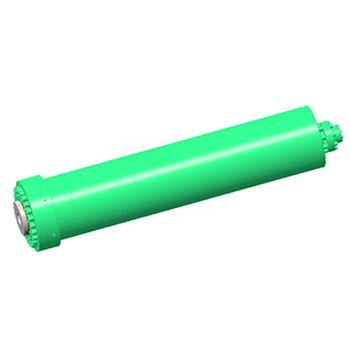Hidraulički cilindri se koriste za pružanje sile i pokreta u širokom rasponu mašina. Međutim, sa vremenom ovi cilindri mogu početi imati probleme zbog zaključenog vazduha u hidrauličkoj tekućini, što može rezultirati lošim performansama ili štetom. Očišćavanje hidrauličkog cilindra - Važnost prilikom održavanja. Proces očišćavanja hidrauličkog cilindra je važna aktivnost održavanja koja uklanja vazdušne kese, omogućava bolje performanse i sprečava štetu.
Razumevanje procesa:
To je proces određenih koraka koji su neophodni za najbolje performanse i moraju se izvršiti tijekom očišćavanja hidrauličkog cilindra. Ako pažljivo prate te korake jedan po jedan, osigurajte da ih ispravno izvršite, što će poboljšati performanse cilindra i produžiti njegov životni vek.
5 koraka koji treba pratiti sa važnošću dok očišćavate svoj hidraulički cilindar
Prijavite se Identifikujte cilindar: Prvi korak u čišćenju hidrauličkog prostora je prepoznavanje tačnog bara koji treba očistiti. Proverite znake umanjenog performansi ili neobičnih zvukova.
Dakle, kada znate koji cilindar se menja, budite u hitu i uvijek imajte sva oprema koja je potrebna pod rukom. To se razlikuje od rezervoara gde cuvamo hidrauličku tekućinu do alata itd. i samog cilindra dok ovaj blok uključuje mogućnosti protiv neslučajne aktivacije pokretača pomicanja zaključavanjem solenoida na bilo kojoj ekstremnoj forgiranoj poziciji uz mogućnosti poput spoljnog valjeva Dodatni valjevi / veze ako su potrebni u tim slučajevima.).
Izbacite zaključenu vazduh: Kada je vazduh zaključan u hidrauličkom cilindru, morate ga izbaciti pažljivo otvaranjem Ventila za otpuskanje. Ventil se obično nalazi na dnu cilindra.
Pratite nivo tekućine - dok krpite svoj robački cilindar, bilo bi dobro da pratite i dopunite hidrauličnu tekućinu u rezervoaru. Tijekom procesa može se smanjiti, pa se uvjerite da je napunjeno kada je to potrebno.
Testirajte cilindar: Nakon što ste krpili sve četiri kuta i uvjerili se da vaš glavni cilindar ima dovoljno tekućine, pređite na testiranje funkcije. Uključite cilindar i testirajte ga kako biste se uvjerili da sve radi ispravno.
Uvod za početnike: - Jednostavni koraci
Ako se prvi put upoznavate s svijetom održavanja ili ste tehničar sa godinama iskustva, krpanje hidrauličkog cilindra može izgledati kao strašan zadatak. Ali početnici ne trebaju brinuti jer mogu pratiti ovaj jednostavan korak po koraku vodič kako bi to uradili.
Prikupite alate: Da biste proces bio jednostavan, potreban će vam ključ ili šarg, prazan posud za držanje bilo koje vode koja će iztechati tijekom održavanja i obilac.
Nađite cilindar: Napomenite ga preko njegove operacije, pronaći ćete koji hidraulički cilindar treba krpati.
Povlačenje tekućine: Pronađite ventil za otpuštanje (na većini cilindara, nalazi se blizu baze)
Otvorite ventil za otpuštanje: Koristeći ključ, otvorite (iskrućujte) ventil za otpuštanje da bi se iz njega isklizivao vazduh i hidraulička tekućina.
Zatvorite ventil za otpuštanje: Nakon što je svi pritisak otpušten, ponovo zatvorite ventil za otpuštanje.
Testiranje cilindra: Proverite da li cilindar radi kao što treba nakon otpuštanja kako bi radio na svoju najbolju performansu.
Greške koje treba izbezeti i korisni saveti:
Postoje nekoliko uobičajenih grešaka koje se mogu napraviti prilikom otpuštanja hidrauličkog cilindra, pa ih izbegavajte. Takođe, dobro je dodati savete za povećanje efikasnosti ispod:
Izbežite brzo otvaranje ventila za otpuštanje - Ako to ne uradite, može doći do oštećenja cilindra. Otvorite ventil sporo - nemojte gažiti.
Omogućava najbržu i najefikasniju metodu uklanjanja vazduha, koristite alat za otpuštanje hidrauličkog cilindra.
Uobičajena greška: oštećenje cilindra zbog zanemarenja provere nivoa hidrauličke tekućine. Punite rezervoar često tekućinom po potrebi.
Savet za efikasnost: Kupite rezervoar hidraulične tekućine sa vidnim stakom, što vam omogućava vizuelnu proveru nivoa ulja.
Uobičajena greška: Ako ne ispitate cilindar nakon otpuštanja vazduha, mogu se produžiti problemi sa performansama. Uverite se da testirate cilindar na svakom odgovarajućem koraku.
Savet za efikasnost: Pre nego što skinete cilindar, koristite pretest otpuštanja kako biste proverili moguće probleme sa performansama.
Profesionalno otpuštanje hidrauličnih cilindara - U tehničkim detaljima:
Otpuštanje hidrauličnih cilindara nije samo vremenski i fizički zahtevan proces, postizanje najboljih rezultata zahteva metode koje mogu pomoći u ubrzavanju procesa a ipak ostati efikasne:
KAKO: Koristite alat za otpuštanje hidrauličnog cilindra za brzo i lako uklanjanje vazduha.
Postupak: Korišćenje vakuum pumpe je namenjeno ubrzavanju otpuštanja vazduha iz cilindra.
Postupak: Dok radi hidraulička pumpa, otpustite cilindar.
Stvari koje treba znati od stručnjaka prilikom rada sa crkavi hidrauličnim cilindrom:
Otpuštanje vazduha iz hidrauličkih cilindara je zadatak koji zahteva pažljivu pažnju prema najboljim praksama, kao što stručnjaci ističu važnost ispravnog otpuštanja vazduha kako bi cilindri radili na vrhunskom nivou i ne bili oštećeni. Šta je bolje od učenja na osnovu saveta stručnjaka prikazanih u ovom članku.
Savet stručnjaka: Uvek pregledajte informacije proizvođača pre početka bilo kog tipa održavanja hidrauličkih cilindara.
Napomena: Uvek koristite svez hidrauličku tekućinu da ne zarazite i da štite svoj cilindar.
Savet stručnjaka: Da biste spreventovali vazduhove praznine i otpustili vazduh iz cilindra, postavite ga u vodoravnu poziciju.
ANTIFRIZ-BOJA, GORIVO ZEMALJSKA HIDRAULIČKA TEKUĆINA IRRITACIJA Nosite odgovarajuću osobnu zaštitnu opremu prilikom rukovanja hidrauličkom tekućinom kao što je istaknuto u INFORMACIJAMA O BEZBEDNOSTI ANTIFRIZ/BOJARANT, FFBL ZEMLJA/GIDRAULSKA TEKUĆINA.) PAŽNJA NA KOŽU Ne dozvolite potencijalno iritirajuće tekućine da dodirnu vašu kožu.
U sažetku, otpuštanje vazduha iz hidrauličkih cilindara je osnovno preventivno održavanje koje će donijeti veliki korist od držanja opreme u optimalnom stanju duže. Otpuštanje hidrauličkog cilindra, kada se vrši na pravilan način, bez činičnih grešaka i prateći efikasne tehnike, znači da može biti jednostavan ali učinkovit proces. Pratite uputstva proizvođača i savete stručnjaka kako bi se ovo održavanje moglo izvršiti na pravilan način.

 EN
EN
 AR
AR
 BG
BG
 HR
HR
 CS
CS
 DA
DA
 NL
NL
 FI
FI
 FR
FR
 DE
DE
 EL
EL
 HI
HI
 IT
IT
 JA
JA
 KO
KO
 NO
NO
 PL
PL
 PT
PT
 RO
RO
 RU
RU
 ES
ES
 SV
SV
 CA
CA
 TL
TL
 IW
IW
 ID
ID
 LV
LV
 LT
LT
 SR
SR
 SK
SK
 UK
UK
 VI
VI
 HU
HU
 TH
TH
 TR
TR
 FA
FA
 MS
MS
 GA
GA
 CY
CY
 KA
KA



